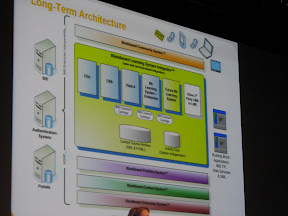Steve Ryan and I attended the CAL 2007 conference in Dublin last week. The conference subtitle was “development, disruption and debate”, so there was a stream about introducing ICT into education in developing countries, which I confess I avoided. Also there was much use of the word “disruption” in presentation titles (often with little justification).
The main difference between this and other conferences I’ve attended was that it covered not just HE/FE but learning at all levels, including primary, secondary and pre-school education. This added welcome variety to the presentations.
One theme that emerged was the idea of the “Grammar of Schooling”. This comes from Tyack and Tobin (1994) and represents the idea that the established forms of education have become so embedded that they prevent any serious transformative innovation from happening. See the summary of the “design for learning” symposium below for more on this.
I presented a paper entitled “Reuse, repurposing and learning design – lessons from the DART project” which was the last talk of the conference and quite poorly attended, although it seemed to go down well, and we’ve had two expressions of interest in using our software as a result.
Overall, a pretty good conference (despite the unwelcome reappearance of ‘activity theory’ in several papers). It only happens every other year; next one is Brighton 2009.
Ref:
Tyack, D. and Tobin, W. 1994. The “Grammar” of Schooling: Why Has It Been So Hard to Change? American Educational Research Journal, 31 (3): 453-479.
Summaries of selected presentations:
Peppi Taalas from the University of Jyväskylä presented a series of cross-sectional studies of the use of ICT by 100-200 language teachers in schools, at multiple time points between 1994 and 2005. This is obviously an interesting period because it coincides with the life span of the web. Results showed that ICT is now used by almost all teachers in the preparation for their teaching. However, while the use of ICT in the teaching itself has increased, it is still not mainstream, and a whole 20% of teachers do not use ICT at all in their teaching. The main type of use of the web is for finding resources which are then used in more traditional ways. Training in the use of ICT is widespread but seems to have little effect on take-up. However, teacher involvement in projects does seem to have a effect.
Bas Andeweg from Delft University of Technology presented results of a study that compared the effectiveness of different forms of PowerPoint presentation on retention. The three modes compared were “extensive textual description”, “concise textual description” (bullet points) and images (representing the same concepts as the text). Results showed that the audience performed better in post-tests when they had experienced the extensive textual description – which is the opposite of what we preach in our presentation skills class. Other results suggested that the use of extensive text slides can compensate for a poor presentation style – perhaps because they give the audience the chance to ignore the speaker and make their own notes from the text. I had some complaints with the study – in particular the images they used seemed particularly clunky and poorly designed – but still it raises questions.
Jill Clough from the OU had a nice project using PDAs with GPS capability to create a nature trail, with spatial ‘hotspots’ that released information to you when you entered them. Students would use the PDAs to receive this information and then take photos and record data, to be contributed later to a shared blog. Seemed promising, most results focussed on a lack of usability of the software used.
There was a symposium on “design for learning” that gave us a chance to see and compare two “pedagogic planners” – the Laurillard one that we know about, and another one called Phoebe. The Laurillard planner which started as a baffling spreadsheet and became a more usable Shockwave app, is now moving to an HTML version. Only screenshots were available, but it did look much simpler again, which should help its wider adoption. The aim is to make its purpose “recognisable to lecturers” so that they can be eased into the terminology of learning design. Isobel Falconer from Glasgow Caledonian presented results from a study of the use of “pedagogical patterns”, finding that participants roundly rejected the whole idea. The problem seems to be in the tension between the need for such patterns to be generic, and the need for teachers to see real, contextualised examples of use in order to be inspired by them, to see evidence of effectiveness and to envisage how they might use them.
The discussion afterwards was interesting. Isobel said that teachers using ICT were mostly applying a “constructivist layer” over the same old instructivist framework, because the learning outcomes are predetermined to be instructivist. In the students, there is a tension between the drive to successful achievement of these predetermined learning outcomes (i.e. strategic learning for assessment), vs. actual improvement of learning. Liz Masterman from Oxford University said that teachers are constrained by their institutional practices (i.e. assessment and more) and so any pedagogical planner needs to account for that. Tom Boyle from London Met said that the use of assessment to force participation is “using a behaviourist tool to enforce constructivist learning”, which is an interesting way of looking at something I had found unproblematic untli now. A lot of this stuff about institutional constraints feeds back into the “Grammar of Schooling” argument above.
Selected papers from the conference will be published in a forthcoming special issue of Computers and Education.







